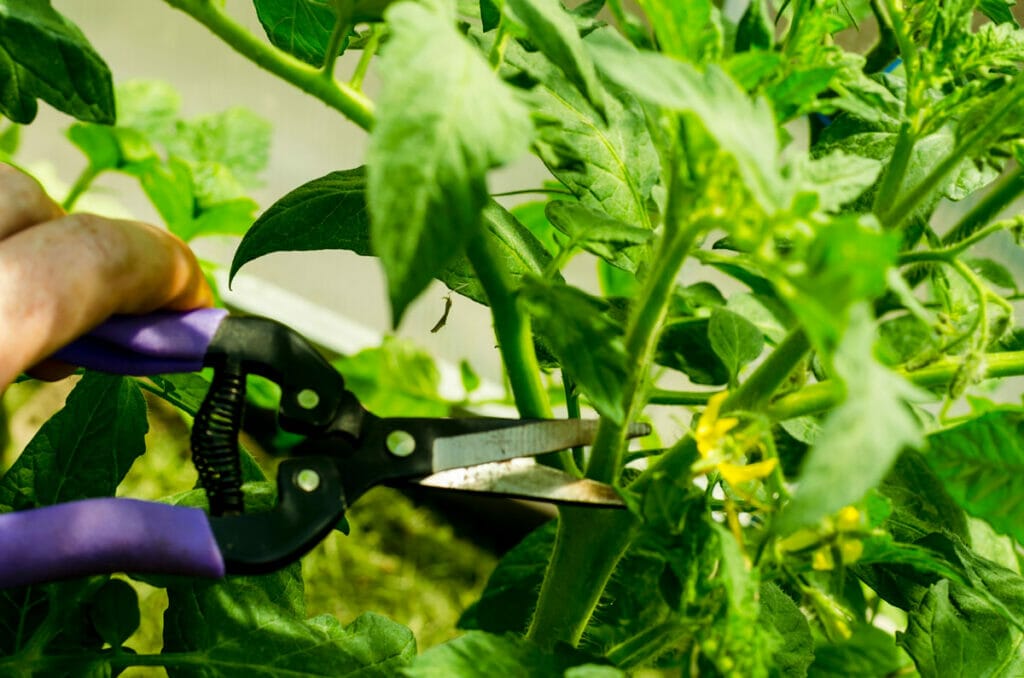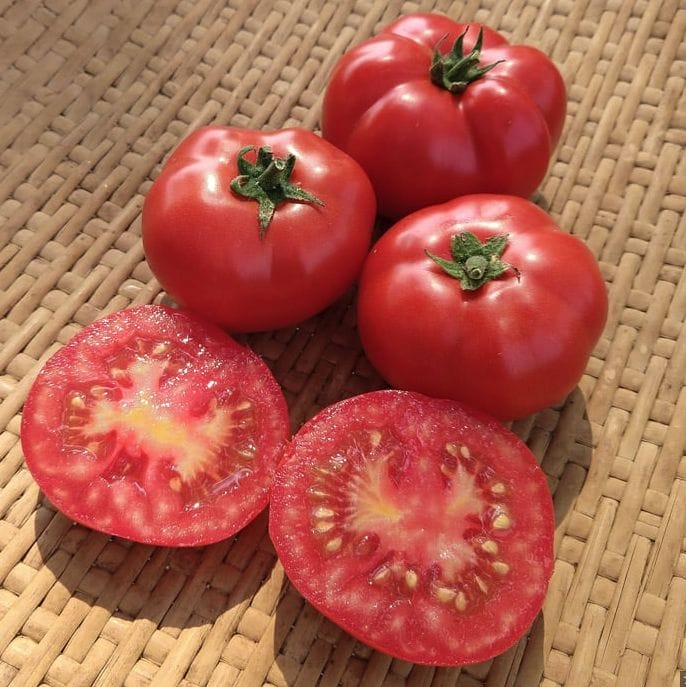Dwarf Tomato Plants

There’s a certain magic to dwarf tomato plants. Imagine the vibrant, vine-ripened tomatoes you’ve always loved, but now picture them in a compact and space-efficient form.
These little powerhouses, true to their name, are small in stature but immense in productivity, opening up the world of home gardening to those who may have thought they didn’t have the space or means. Dwarf tomato plants are more than just their size; they represent resilience, adaptability, and the potential for abundance in small packages.
They break the myth that you need large garden plots to grow tomatoes successfully, making it possible for apartment dwellers, those with small yards, or people simply seeking to maximize their gardening space to enjoy the joy of growing their produce.
Every variety of these tomatoes carries a unique story, a distinctive palette of colors, and a symphony of flavors. Like flowers that represent sadness, dwarf tomatoes have a profound beauty, enriched by the balance of their vibrant allure and the depth of their roots.
Embarking on a journey with dwarf tomatoes is not just about gardening; it’s about embracing a sustainable lifestyle, the joy of harvest, and the marvel of nature.
Get ready to delve into the fascinating world of dwarf tomato plants, from understanding their unique characteristics to exploring their care, disease prevention, harvest, and the myriad of varieties waiting to be discovered.
This journey promises to be as rewarding as it is educational and as flavorful as it is colorful.
Characteristics of Dwarf Tomato Plants
Compact Size and Unassuming Stature
Don’t be fooled by the diminutive name, dwarf tomato plants are giants in their own right, showcasing a brilliant display of resilience and productivity. ù
Compact in size and easy to maintain, they offer a viable solution for gardeners with limited space. Their unassuming stature, typically between 2 to 4 feet, might not be as towering as traditional tomato vines.
However, their ability to flourish in smaller containers and indoors makes them a compelling option for city dwellers or those with less room to spare.
Bountiful Production and Varied Colors
An unmistakable characteristic of dwarf tomato plants is their prolific yield. They generously bear fruits, which can sometimes surprise those unfamiliar with their vigorous nature. Moreover, these small tomatoes don’t shy away from showing off their varied color palette. From the deep crimson of a summer sunset to the blushing pink that reminds one of the flowers that represent sadness, their vibrant hues add color to any garden or balcony.
Distinct Flavor Profiles
Dwarf tomato plants aren’t just about aesthetics, they bring to the table an assortment of flavor profiles. From the rich and sweet to the tart and tangy, each variety offers a unique taste experience. Despite their size, these tiny tomatoes pack a punch when it comes to taste, a testament to the fact that the best things often come in small packages.
Understanding the Cultivation Process of Dwarf Tomatoes
The Perfect Soil Mix
Growing dwarf tomatoes starts with getting the soil mix right. These plants prefer well-draining, rich soil with a slightly acidic pH level. Add organic matter or compost to enrich the soil, ensuring it provides a balanced blend of nutrients. Ensuring the right soil conditions is crucial for healthy and robust growth.
Optimal Sunlight and Temperature Conditions
Sunlight is another crucial factor in the successful cultivation of dwarf tomatoes. They need a good amount of sunshine, at least 6 to 8 hours daily, to thrive. While they are pretty adaptive, extreme temperature swings are not their favorite. A consistent temperature of 70 to 85 degrees Fahrenheit during the day works best for their growth.
Nurturing through Watering and Fertilizing
Last but certainly not least, proper watering and fertilization play a pivotal role in the growth of dwarf tomatoes. Watering should be deep but not too frequent, allowing the soil to dry out between watering sessions. Overwatering can lead to waterlogged soil and root rot. Similarly, fertilizing should be done carefully, providing enough nutrients but not overdoing it to avoid burning the roots. A balanced tomato fertilizer can promote healthy growth and a bountiful harvest.
Methods for Pruning and Care of Dwarf Tomato Plants
Understanding the Proper Pruning Technique
While dwarf tomato plants may not demand as much pruning as their larger counterparts, a little care in this area can go a long way in maintaining their health and maximizing their fruit yield. Start by identifying the plant’s main stem, then look for side stems, often called ‘suckers.’ These are usually found in the joint between the main stem and a branch. While a few suckers can aid in photosynthesis and growth, too many can cause the plant to divert energy from fruit production to leaf growth. Hence, occasional pruning of these suckers is advisable.
Watering and Nutrient Requirements
Much like nurturing any other plant, dwarf tomatoes need their fair share of attention. Regular watering is crucial, but be mindful of watering deeply and less often rather than shallowly and frequently, which promotes deep root growth. As for nutrients, using a well-balanced tomato-specific fertilizer will ensure that the plants receive all the essential nutrients they need to grow robust and healthy. You might think of these little acts of care as sending a bouquet that represents sadness – it may not alter the course of life, but it adds a touch of affection and can bring about a positive change.
Care in Varied Climate Conditions
Contrary to popular belief, dwarf tomato plants can thrive well beyond summer, with some varieties growing successfully in cooler climates. In such cases, cloches or mini-greenhouses can help protect the plants from frost. Alternatively, providing some shade can prevent the plants from getting scorched if the climate is too hot. Remember, adopting care to specific climate conditions goes a long way in ensuring a bountiful harvest.
Common Diseases and Pests Affecting Dwarf Tomatoes
Common Diseases Impacting Dwarf Tomatoes
While dwarf tomatoes are generally quite robust, they are not entirely immune to diseases. Common issues include early blight, which presents as dark spots on leaves and stems, and late blight, causing large, irregularly shaped patches of discoloration. Fusarium wilt and Verticillium wilt can also affect these plants, causing the leaves to yellow and wilt. Regular inspection of the plants and early detection can help manage these diseases and keep the plants healthy.
Pests that Trouble Dwarf Tomatoes
Regarding pests, the dwarf tomatoes’ list of unwanted guests includes common culprits like aphids, tomato hornworms, and stink bugs. Aphids are tiny insects that suck the sap out of the plant, while tomato hornworms are large caterpillars that munch on the leaves and fruits. Stink bugs are shield-shaped insects that feed on the fruits, causing discoloration and damage. Pesticides can help manage these pests, but organic and non-toxic alternatives can often be just as effective and are kinder to the environment.
A strong defense is often the best offense.
Keeping the plants healthy with good watering practices and regular feeding can help them withstand disease and pest attacks. Removing affected leaves or fruits early can prevent the spread of disease. Using organic, disease-resistant varieties can also be a good strategy.
Pest and disease management is like life itself – it’s all about balance, vigilance, and timely intervention. Even when dealing with situations as somber as flowers representing sadness, there’s always a way to turn things around and cultivate growth and resilience.
Methods for Pruning and Care of Dwarf Tomato Plants

Understanding the Proper Pruning Technique
While dwarf tomato plants may not demand as much pruning as their larger counterparts, a little care in this area can go a long way in maintaining their health and maximizing their fruit yield. Start by identifying the plant’s main stem, then look for side stems, often referred to as ‘suckers’. These are usually found in the joint between the main stem and a branch. While a few suckers can aid in photosynthesis and growth, too many can cause the plant to divert energy from fruit production to leaf growth. Hence, occasional pruning of these suckers is advisable.
Watering and Nutrient Requirements
Much like nurturing any other plant, dwarf tomatoes need their fair share of attention. Regular watering is crucial, but be mindful of watering deeply and less often rather than shallowly and frequently, which promotes deep root growth. As for nutrients, using a well-balanced tomato-specific fertilizer will ensure that the plants receive all the essential nutrients they need to grow robust and healthy. You might think of these little acts of care as sending a bouquet that represents sadness – it may not alter the course of life, but it adds a touch of affection and can bring about a positive change.
Care in Varied Climate Conditions
Contrary to popular belief, dwarf tomato plants can thrive beyond summer, with some varieties growing successfully in cooler climates. In such cases, cloches or mini-greenhouses can help protect the plants from frost. Alternatively, providing shade can prevent the plants from getting scorched if the climate is too hot. Remember, adopting care to the specific climate conditions goes a long way in ensuring a bountiful harvest.
Tips for Harvesting and Storing Dwarf Tomatoes

The Art of Harvesting
Harvesting dwarf tomatoes is like capturing a moment of perfection. The right time to reap is when the fruit is full-colored but firm to the touch. Seeing these tiny orbs ripen to their peak, much like flowers that represent sadness reaching their bloom is quite a sight. Each tomato carries a unique mix of beauty and melancholy. Remember, every variety has its color at maturity, so don’t assume they all turn red. Some might be green, yellow, or even a blushing pink when ripe and ready.
Storing Freshly Picked Tomatoes
Once harvested, how you store your dwarf tomatoes can greatly influence their taste and shelf life. Room temperature is ideal for these fruits. Avoid refrigeration, as it tends to sap the flavor out of the tomatoes. A simple trick for those not fully ripe is to keep them in a paper bag with a ripe banana. The banana emits ethylene gas, a natural ripening agent, which will help the tomatoes ripen perfectly.
Preserving for Long Term Use
For tomatoes, you wish to store long-term, consider methods such as canning, drying, or freezing. Canning is a popular method as it helps retain flavor and nutritional value. Drying tomatoes can be done in an oven or a food dehydrator, resulting in flavorful, concentrated tomato pieces used in various dishes. Freezing is perhaps the simplest method, where you can freeze whole tomatoes or process them into sauces or purees before freezing.
Exploring Different Varieties of Dwarf Tomato Plants
Embracing the Color Spectrum
Dwarf tomato plants offer a delightful assortment of colors. Varieties like the ‘Dwarf Lemon Ice’ with its pale yellow fruits and ‘Rosella Purple’ bearing deep pink to purple tomatoes are just the tip of the iceberg. Each color hints at a unique flavor profile, making them a treat for the eyes and the palate.
Discovering Flavors
Dwarf tomatoes aren’t just a visual delight; they’re a culinary journey too. Varieties like ‘Dwarf Mr. Snow’ offer a mild and sweet flavor, while ‘Sleeping Lady’ provides a rich and smoky taste. Much like tasting different wines, exploring the flavors of different dwarf tomatoes is an adventure, offering nuanced taste profiles that can elevate your cooking to new heights.
The Charm of Heirloom Varieties
Among the myriad choices, heirloom dwarf tomatoes hold a special place. These varieties have been passed down through generations, preserving the unique characteristics of flavor, color, and shape. Heirloom varieties like ‘Dwarf Emerald Giant’ and ‘Dwarf Wild Fred’ are not just about the tomatoes they produce. They carry stories and traditions, embodying a legacy similar to the poignant beauty of flowers that represent sadness, touching hearts and taste buds alike.







